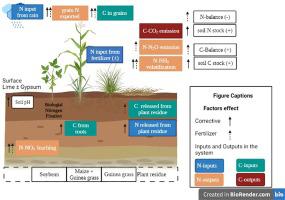Geoderma ( IF 5.6 ) Pub Date : 2022-05-05 , DOI: 10.1016/j.geoderma.2022.115909 Jéssica Pigatto de Queiroz Barcelos 1 , Murilo de Souza 1 , Carlos Antonio Costa do Nascimento 1 , Ciro Antonio Rosolem 1

|
Lime application has been associated with N and C losses from agricultural systems through NO3– leaching, N2O and CO2 emissions. However, we hypothesized that in an intensive crop system where soybean is grown in rotation with maize intercropped with a forage grass, liming associated with the application of gypsum to ameliorate the subsoil, and N fertilization increase soil N and C by improving root and crop growth. To evaluate the interaction of lime, gypsum and N fertilizer on soil and N and C partial balances, an experiment was carried out under no-till, where soybean was grown in rotation with maize intercropped with Guinea grass (Megathyrsus maximus cv Tanzânia) as relay crop. Lime and gypsum were applied before soybean planting in October 2016 and October 2017. Two N rates (0 and 160 kg ha−1 yr−1 of N as ammonium sulphate) were applied to maize annually. Outputs through N-NO3– leaching, N-N2O emission and N-NH3 volatilization did not exceed 30 kg ha−1 of N in two years. The N exported in grains consisted in 96% of the N output and was greater with fertilizer and lime. Soil acidity amelioration and N-fertilization favoured soil C fixation with high plant biomass production (C in plant residue, roots, and grains), while soil C-CO2 emission was not affected, and soil C increased. Although the partial N balance was negative, there was an increase in soil N, probably due to biological N fixation by soybean, which was not considered in the partial balance. We concluded that lime and gypsum application, along with an adequate N fertilization, to a tropical highly-weathered soil with soybean cropped in rotation with maize-guinea grass intercropping benefit N and C cycles and the environment in the short-term, increasing soil N and C stocks and reducing GHG emitted to the atmosphere.
中文翻译:

在大豆和玉米-几内亚草间作系统中,土壤酸度改善在短期内改善了 N 和 C 循环
石灰应用与农业系统通过 NO 3浸出、N 2 O和 CO 2排放造成的 N 和 C 损失有关。然而,我们假设在集约化作物系统中,大豆与玉米与牧草间作轮作,石灰与石膏的应用相关,以改善底土,施氮肥通过改善根系和作物生长来增加土壤 N 和 C . 为了评估石灰、石膏和氮肥对土壤的相互作用以及氮和碳的部分平衡,在免耕条件下进行了一项试验,其中大豆与玉米和几内亚草(Megathyrsus maximus )轮作。cv Tanzânia)作为接力作物。石灰和石膏在 2016 年 10 月和 2017 年 10 月的大豆播种前施用。每年向玉米施用两种施氮量(0 和 160 kg ha -1 yr -1的 N 作为硫酸铵)。通过 N-NO 3 –浸出、NN 2 O 排放和 N-NH 3挥发的输出在两年内不超过 30 kg ha -1的 N。谷物中的 N 输出占 N 输出的 96%,肥料和石灰更大。土壤酸度改善和施氮肥有利于土壤固碳,植物生物量高(植物残体、根和谷物中的 C),而土壤 C-CO 2排放不受影响,土壤 C 增加。虽然部分氮平衡是负的,但土壤氮有所增加,可能是由于大豆的生物固氮作用,这在部分平衡中没有考虑。我们得出的结论是,在热带高风化土壤中施用石灰和石膏以及充足的氮肥,大豆轮作与玉米-几内亚草间作有利于短期内的 N 和 C 循环和环境,增加土壤 N和 C 库存并减少排放到大气中的温室气体。











































 京公网安备 11010802027423号
京公网安备 11010802027423号